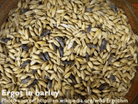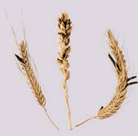| | 2015 - Reducing impacts of ergot alkaloids on performance of growing lambs
Lethbridge Research Centre, Alberta
 | If you Google “ergot” you will find photos like the two here. It’s a disease of grasses and cereal crops mainly growing on rye, wheat, barley and triticale. The fungus has been linked to human poisoning since the Middle Ages.
Historically ergot hasn’t been much of a problem for Alberta flock owners. It has more commonly been seen in climates with moist, cool and cloudy growing seasons. In the past few years variable dry conditions, hail and heavy rainfall have triggered increased levels of ergot in grains.
 |
 | Grain growers know ergot affects the quality and yield of their grain crops. It’s become a growing problem for livestock producers. Ergot produces alkaloids (organic compounds containing nitrogen). When enough ergot is consumed, alkaloids cause ergot poisoning in mammals, humans, cattle, swine and sheep. Ergot toxicity restricts blood flow. That can lead to gangrene – lameness, even loss of ears, tails, or hooves – the more familiar symptoms of ergot poisoning in cattle.
Dr. Kim Stanford, Lethbridge Research Centre, with funding from ALMA, carried out a research project looking into ergot and its impact on sheep and lambs. |
 |  |
This year the research showed even a small amount of ergot can cause major health issues with sheep. Important early findings show:
- One ergot body may be totally safe, another quite deadly. Different ergot bodies have dramatically different levels of alkaloids. You simply can’t tell how toxic the ergot will be by looking at a grain sample or by counting the number of ergot bodies.
- The Canadian Food Inspection Agency Standards for feed, and previous assumptions that sheep and cattle have similar tolerances to ergot, may be incorrect.
- There is no margin of safety for breeding stock – ewes or rams. Restricting blood flow to reproductive organs increases abortions, low birth weights, and poor-doing lambs. Restricting the hormone prolactin may completely eliminate milk production contributing to poor lamb viability and growth. Milk production does not recover over the lactation, no matter what is fed.
- Standard feed testing for nutrients does not determine ergot toxicity. Specialized toxicological testing is required. Currently only Prairie Diagnostic Services, Saskatoon, is able to do accurate testing for ergot toxicity.
- Avoiding any use of ergot-contaminated grain is the best prevention.
Project leads
Dr. Kim Stanford, A&F, Lethbridge Research Centre
Dr. Barry Blakley, Western College of Veterinary Medicine, University |
|
|